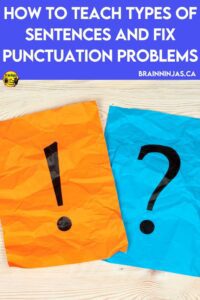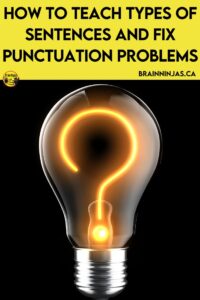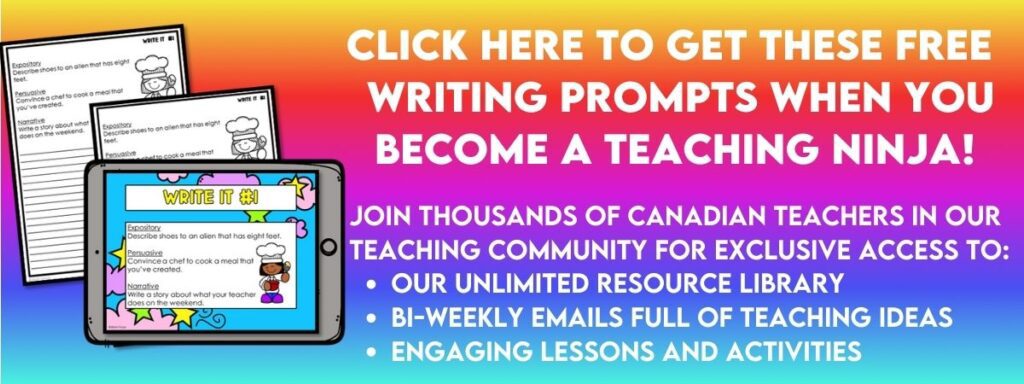
Often when the school year starts, we do a few different writing activities to get a sense of how well students can (or cannot) write. One of the things we continually see is the lack of conventions regardless of whether students write by hand or type it into a device. We found that a simple lesson around the different types of sentences changed many of the punctuation problems. Come read about the lesson and get some ideas for your classroom.
Start by Teaching the Types of Sentences
There are four main types of sentences that we use in the English language.
An exclamatory sentence is a forceful statement that expresses emotion. It is punctuated with an exclamation mark at the end (!). An example is “Fire!”
An interrogative sentence asks a question. It is punctuated with a question mark at the end (?). An example is “Have you checked the temperature?”
A declarative sentence makes a statement. The statement doesn’t evoke any particular emotion. It is punctuation with a period at the end (.). An example is “It’s sunny outside.”
An imperative sentence is a command. It is punctuated with a period at the end (.). An example is “Put the dishes away.”
We usually teach these sentence types by doing a quick lesson where students write the definitions and examples in their language arts book. We have a lesson ready to go that we will link for you below. The lesson includes definitions and examples of each sentence type. Students create a reference page they can use for all the activities and for their writing for the whole school year.
Practice the Types of Sentences

Once you have taught the definitions, start practicing identifying different types of sentences. Explain that students can check the punctuation first because that can be a clue. Then they should look at what the sentence is trying to do to get the type.
Read or write these sentences and have your students figure out the sentence type. We have put the answer in brackets after the sentence.
Clean your room. (imperative)
A spider! (exclamation)
We shovelled the snow off the driveway. (declarative)
Where did you put your boots? (interrogative)
Make Practicing Easy Without Planning

We have several sets of task cards that also come with the lesson. These cards feature different types of sentences and can be done as a set of task cards by printing them out, online using Google Slides or even as an assessment using Google Forms. They feature different themes. The lessons are the same, but the cards in each set are completely different. These can be used to practice, review or to assess students.
Each of the cards features a sentence. Students have to determine the type of sentence by writing it on an answer key (or selecting it if working digitally).
Pirates Types of Sentences Activity on TpT ($USD) or our BN Shop ($CAN). This one is our favourite because it uses pirate language and silly phrases. We’ve included a pirate word glossary to help you out. It’s also a great activity for Talk Like a Pirate Day on September 19.
Winter Types of Sentences Activity on TpT ($USD) or our BN Shop ($CAN).
Christmas Types of Sentences Activity on TpT ($USD) or our BN Shop ($CAN).
Halloween Types of Sentences Activity on TpT ($USD) or our BN Shop ($CAN).
Examine a Professional Writing Sample

Take a piece of writing from any book. Photocopy or take a picture so that you can draw directly on the page. Colour code the different types of sentences so that each type has a different colour. Read each of the sentences and trace the punctuation with the colour matching the type of sentence. Explain that every single sentence has punctuation.
The type of sentences and the punctuation used depends on the type of writing. For example, a textbook would mostly contain declarative sentences because it provides the reader with information. An exciting mystery would include more exclamatory or imperative sentences because the author wants to put emotion into the story.
Show How Punctuation Can Change the Intent of a Sentence
When a sentence uses different punctuation, the sentence will sound different. Punctuation is one way an author can show the reader how they want a sentence to sound as it is read. This conveys the meaning and the tone. For example, these three sentences have the same words but because the punctuation is different, they are read differently.
The cat is on the mat! This sounds like the cat isn’t supposed to be on the mat.
The cat is on the mat? This sounds like the reader isn’t sure if the cat is on the mat or somewhere else.
The cat is on the mat. This sounds like the cat is on the mat just like the reader said.
Repeat this activity using the phrase “I can’t believe you did that” but don’t give students the punctuation. See if they can figure out how to say the phrase with the punctuation that matches.
Not only does this skill help students with their writing, but it helps with reading, too. When students can read a sentence with the author’s intent, they are more likely to understand the meaning of the sentence beyond decoding the words.
Have Students Apply The Rules to Their Own Writing

Have students choose a sample of their own writing. Repeat the colour coding activity on their writing. Is there punctuation missing? Have them add it with the correct colour. Are there sentences with the wrong punctuation? Have students rewrite the correct punctuation according to their colour coding.
Ask students to look at the sample of writing and check to see if they are using the correct punctuation to show their intent. If the punctuation doesn’t match, give them time to change the words, punctuation or both.
If your students need some inspiration to get writing our posts Challenge Your Students with Writing Activities Every Day or How to Include Different Types of Writing in Your Classroom might be useful.
We can even send you some free writing prompts when you sign up for our email list. If you’re already on the list, you can find the prompts in the Resource Library.

Review the Types of Sentences
Once you’ve taught the lesson and practiced, incorporate the learning into writing and reading activities for the rest of the school year. Even if students don’t name the types of sentences, encourage them to use punctuation to show the intent of the sentence when they read or when they write.
If students start leaving out punctuation or use the wrong punctuation, repeat the colour coding activity. Even just having students circle the punctuation to confirm it’s correct can help students identify where they are making their mistakes.
Do you teach Language Arts?
You might find these posts helpful:
Unravel the Magic of Fractured Fairy Tale Activities!
15 Ways to Engage Readers During Your Read-Aloud
Give Your Reading Instruction an Easy Twist
Research Skills: How to Teach Text Features
How have you used the types of sentences to help your students get better at using punctuation? We’d love to hear your comments below.






